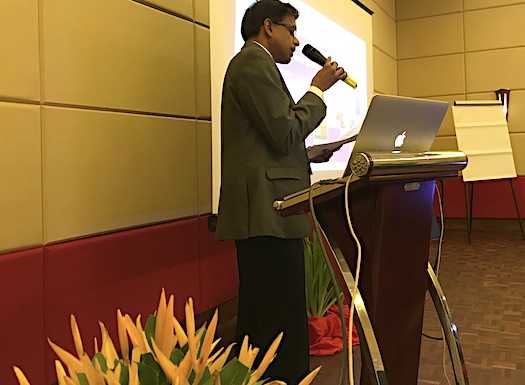In a workshop session on creative content at the Asia Media Summit in Cambodia today, a range of broadcasters gave snapshots of how media is changing in their countries.
All India Radio has 479 Broadcast centres across India that cover more than 99% of the population.
AIR broadcasts in 23 Languages and 179 Dialects.
As well as traditional broadcast transmitters, AIR also broadcasts on digital transmission and has an increasing range of streaming audio outputs via its websites and apps.

“As well as information and entertainment, we put a great emphasis on education,” AIR's Assistant Director of Programs (Policy) Sanjiv Dosajh told delegates.
Examples of the success of All India Radio's education campaigns include voter education and the elimination of Polio across the country.
Agricultural improvements have also been achieved by improved farming methods that were promulgated through AIR. Indian farmers now grow a much hardier strain of rice, which they call 'Radio Rice' because they learnt about it through the farming radio programs.
Halitesh Datt from Fiji's Department of Information explained how broadcasting in Fiji is embracing social media platforms to get government information messages across.
Fiji’s population stands at 884,887, out of which half of the population is below the age of 27 years and 70% of population is below the age of 40. Fiji has 2 television stations, two newspaper companies, 2 radio companies who have stations in all major languages, i.e. English, Hindi and I Taukei (Fijian).
The department produces 4 radio programs each week in Hindi and Fijian and 4 live radio talkback shows. These shows integrate with a range of social media strategies which compliment them. “It was imperative that the Fijian Government has its presence on key social media sites,” said Datt.
The Fijian Government’s Facebook Page has the largest reach of the Department's social media platforms, with 161k follows and more than 100k people reached per week in the small South Pacific island. Contributors are required to post information and pictures quickly so that the page is always seen as relevant and current.
Sherlyn Hassan, a media Rrsearcher from Seychelles discussed the importance of local issues and local connections in radio and tv programs.
Radio programs bieng produced include:
These programs employ a range of engagement strategies including: —voting; —live discussions through texts, calls, apps; —public calls and games.
The shows are distributed online as well as on air, on platforms including Youtube, Soundcloud, Facebook, website and text messaging. The national broadcaster has also introduced a new app which extends programming to smart phones.
Trung Hieu from Vietnam's national broadcaster VoV spoke about the expansion of Voice of Vietnam to a range of social media and online platforms, which is important because 64 million of the country's 96 million population use the internet. 55 million are active social media users, which “poses great challenges to mainstream news sites.”
Vietnam's online media users spend nearly 7 hours per day using the internet, with about 4 hours of that being spent consuming audio or video content (2 hrs 43 mins) and streaming music (1 hrs 21 mins).
72% of internet users consume their content on smart phones, with another 28% consuming the content on early generation dumb phones.
VOV was established in 1945 and continues to keep up to date with new technology. News feeds, video and audio posts are all pushed out on digital platforms as well as on traditional broadcast channels by VoV.
Vietnam has a wide range of newspapers and magazines, plus national and local radio and tv channels. Each province has a radio station of its own, as well as national services.
While there is a strong uptake of social media, “radio still holds a strong place in media consumption, with 50% of people in Hanoi using radio and higher percentages in the provinces.”
Vov has “expanded its radio transmissions to the South China Sea and to many regions of the world via broadcast and online streaming.” Television generates the highest advertising revenues.
The most popular types of programs in Vietnam are: News/CurrentAffairs, talk shows, music, sports, storytelling and health. Foreign content is also popular on television. One of the most popular radio formats are love and reproductive health programs for youth, because radio can be more anonymous than television and social media.
The presentations took place during a full day Creative Content workshop, sponsored by Radiodays and presented by Steve Ahern, during the Asia Media Summit.
The Asia Media Summit conference continues this week in Siem Reap Cambodia.


